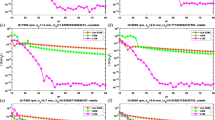Abstract
The dynamic properties of the machine tool structure usually contain multiple modes and significant cross-frequency response functions whose vibration in one direction is caused by a force in the orthogonal direction. To simplify the stability prediction model, the stability of a milling process has been traditionally predicted in the time domain by selecting only the most flexible mode and neglecting the cross-frequency response functions. This paper proposes an effective stability prediction model simultaneously considering multiple modes and the cross-frequency response functions in the time domain. When introducing the cross-frequency response functions, mechanical mobility and impedance transformation method dealing with measured frequency response functions is proposed to establish the dynamic matrix equation. In considering the multiple modes, the approaches of multiple modal parameter normalization on the tool tip and reducing the vibration variable number in modal space are described in detail. The comparisons of numerical simulation results between the proposed method and the frequency domain method demonstrate the effectiveness of the proposed model. A cutting experiment produces results in agreement with the theoretical prediction. The analysis of the numerical simulation and the experimental data indicates that the multiple modes have great effect on stability boundary. Additionally, it also shows that the cross-frequency response functions influence the stability boundary increasingly along with the increasing amplitude ratio of the cross-frequency response functions and direct frequency response functions.
Similar content being viewed by others
References
Tlusty J, Polacek M (1963) The stability of machine tools against self excited vibrations in machining. Int Res Prod Eng 1:465–474
Smith S, Tlusty J (1991) An overview of modeling and simulation of the milling process. J Eng Ind 113:169–175
Yang YQ, Liu Q, Zhang B (2014) Three-dimensional chatter stability prediction of milling based on the linear and exponential cutting force model. Int J Adv Manuf Technol 72:1175–1185
Wang MH, Gao L, Zheng YH (2014) Prediction of regenerative chatter in the high-speed vertical milling of thin-walled workpiece made of titanium alloy. Int J Adv Manuf Technol 72:707–716
Solis E, Peres CR, Jiménez JE, Alique JR, Monje JC (2004) A new analytical-experimental method for the identification of stability lobes in high-speed milling. Int J Mach Tools Manuf 44:1591–1597
Mann BP, Young KA, Schmitz TL, Dilley DN (2005) Simultaneous stability and surface location error predictions in milling. J Manuf Sci Eng 127:446–453
Tang WX, Song QH, Yu SQ, Sun SS, Li BB, Du B, Ai X (2009) Prediction of chatter stability in high-speed finishing end milling considering multi-mode dynamics. J Mater Process Technol 209:2585–2591
Wan M, Ma YC, Zhang WH, Yang Y (2015) Study on the construction mechanism of stability lobes in milling process with multiple modes. Int J Adv Manuf Technol 79:589–603
Berglind L, Ziegert J (2015) Analytical time-domain turning model with multiple modes. CIRP Ann Manuf Technol 64:137–140
Cao H, Li B, He Z (2012) Chatter stability of milling with speed-varying dynamics of spindles. Int J Mach Tools Manuf 52:50–58
Zhang XJ, Xiong CH, Ding Y, Feng MJ, Xiong YL (2012) Milling stability analysis with simultaneously considering the structural mode coupling effect and regenerative effect. Int J Mach Tools Manuf 53:127–140
Altintas Y, Budak E (1995) Analytical prediction of stability lobes in milling. CIRP Ann Manuf Technol 44:357–362
Merdol SD, Altintas Y (2004) Multi frequency solution of chatter stability for low immersion milling. J Manuf Sci Eng 126:459–466
Bachrathy D, Stepan G (2013) Improved prediction of stability lobes with extended multi frequency solution. CIRP Ann Manuf Technol 62:411–414
Bayly PV, Halley JE, Mann BP, Davies MA (2003) Stability of interrupted cutting by temporal finite element analysis. J Manuf Sci Eng 125:220–225
Insperger T, Stépán G (2002) Semi-discretization method for delayed systems. Int J Numer Methods Eng 55:503–518
Insperger T, Stépán G (2004) Updated semi-discretization method for periodic delay-differential equations with discrete delay. Int J Numer Methods Eng 64:117–141
Ding Y, Zhu LM, Zhang XJ, Ding H (2010) A full-discretization method for prediction of milling stability. Int J Mach Tools Manuf 50:502–509
Ding Y, Zhu LM, Zhang XJ, Ding H (2011) Numerical integration method for prediction of milling stability. J Manuf Sci Eng 133:031005
Liang XG, Yao ZQ, Luo L, Hu J (2013) An improved numerical integration method for predicting milling stability with varying time delay. Int J Adv Manuf Technol 68:1967–1976
Niu JB, Ding Y, Zhu LM, Ding H (2014) Runge–Kutta methods for a semi-analytical prediction of milling stability. Nonlinear Dyn 76:289–304
Gradišek J, Kalveram M, Insperger T, Weinert K, Stépán G, Govekar E, Grabec I (2005) On stability prediction for milling. Int J Mach Tools Manuf 45:769–781
Mann BP, Edes BT, Easley SJ, Young KA, Ma K (2008) Chatter vibration and surface location error prediction for helical end mills. Int J Mach Tools Manuf 48:350–361
Munoa Dombovari JZ, Mancisidor I, Yang YQ, Zatarain M (2013) Interaction between multiple modes in milling processes. Mach Sci Technol 17:165–180
Altintas Y (2000) Manufacturing automation: metal cutting mechanics, machine tool vibrations, and CNC design. Cambridge University Press, Cambridge
Budak E, Altintas Y, Armarego EJA (1996) Prediction of milling force coefficients from orthogonal cutting data. J Manuf Sci Eng 118:216–224
Author information
Authors and Affiliations
Corresponding author
Rights and permissions
About this article
Cite this article
Tang, X., Peng, F., Yan, R. et al. An effective time domain model for milling stability prediction simultaneously considering multiple modes and cross-frequency response function effect. Int J Adv Manuf Technol 86, 1037–1054 (2016). https://doi.org/10.1007/s00170-015-8129-4
Received:
Accepted:
Published:
Issue Date:
DOI: https://doi.org/10.1007/s00170-015-8129-4




